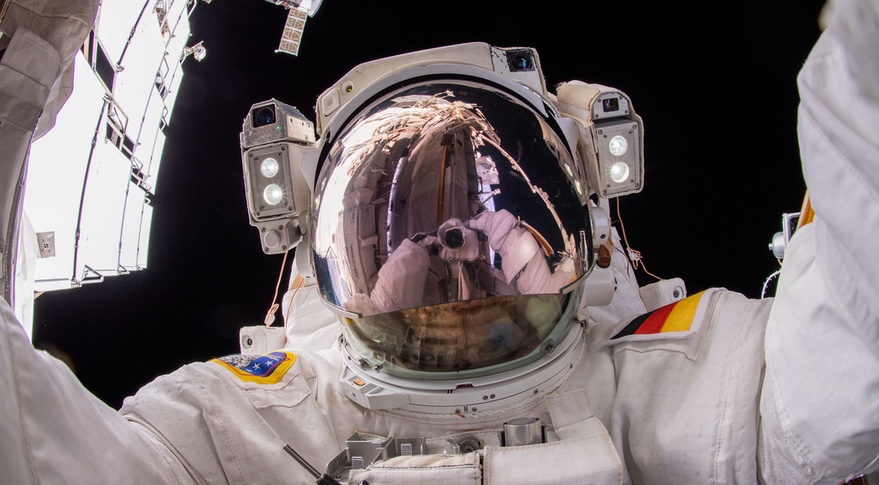WASHINGTON — NASA is continuing to investigate water that leaked into a spacesuit helmet during a spacewalk earlier this year and is holding off on future spacewalks until engineers can resolve the problem.
The leak took place during the most recent spacewalk from the U.S. segment of the station March 23, involving NASA astronaut Raja Chari and European Space Agency astronaut Matthias Maurer. At the end of the nearly seven-hour spacewalk, Maurer reported that water had pooled on his visor, although the thin layer of water, about 20 to 25 centimeters across, did not pose an immediate threat to him.
NASA had provided few updates about the water leak since the incident. However, at a May 12 meeting of NASA’s Aerospace Safety Advisory Panel (ASAP), Susan Helms, a former NASA astronaut who serves on the panel, said that the agency is “no-go” for spacewalks, or EVAs, currently because the ongoing investigation.
“Because NASA is thinking through the risk posture for these suits, which are aging, the EMU is currently no-go for planned EVAs pending an investigation into what they discover,” she said. An EMU, or Extravehicular Mobility Unit, is the spacesuit used by NASA for ISS spacewalks.
At a May 17 briefing about the upcoming Boeing CST-100 uncrewed flight test, Dana Weigel, NASA ISS deputy program manager, confirmed NASA is holding off on routine spacewalks for the time being. The investigation had found no signs of contamination in water in the suit that could be linked to the helmet leak.
The suit itself, she said, can’t be inspected in detail until it’s returned to Earth. NASA is planning to bring the suit back on the next SpaceX cargo Dragon mission, launching to the station in early June.
“From an EVA standpoint, until we understand better what the causal factors might have been during the last EVA with our EMU, we are no-go for nominal EVAs,” she said. “We won’t do a planned EVA until we’ve had a chance to really address and rule out major system failure modes.” That will be done through a review process she compared to a flight readiness review.
Weigel said NASA will consider “contingency” spacewalks by balancing the risk of conducting the spacewalk against the risk posed by the station component that requires a spacewalk to repair or replace. “We’ll have to look at risk versus risk,” she said, which will include the status of the investigation and any measures to resolve the problem.
The Crew-4 mission did deliver several pads designed to be placed inside the helmet to absorb water, she said. Sixteen more pads will be delivered on the Starliner mission.
The “no-go” assessment for routine spacewalks has little practical effect on ISS operations, as no spacewalks were planned until later this year to install a second set of new solar arrays. Weigel didn’t estimate how long the investigation will take.
The incident in March was nowhere near as serious as one in 2013, when water leaked into the helmet of another ESA astronaut, Luca Parmitano, shortly after his spacewalk started. He was able to return to the airlock safely, but only after about one and a half liters of water leaked into the helmet, making it difficult for him to breathe.
Water leaks have been an intermittent issue for the suits for years. “There are still continuing issues with evidence of water in the spacesuit helmets after the conclusion of an EVA or even, in some cases, during an EVA,” Helms said at the ASAP meeting, with no clear root cause for the problem. Besides the addition of the pads, she said engineers are studying “the general level of helmet moisture” normal for the suit.
The water leak, she suggested, is evidence that the decades-old suits are nearing the end of their useful lives. Replacing the suits has been a long-running area of concern for ASAP and others, including the agency’s inspector general. NASA has focused on a new spacesuit, called the xEMU, for Artemis lunar missions, and has proposed measures to extend the life of the current space station suits to 2028.
“The current plan is to extend today’s EMU use to 2028; however, it is increasingly apparent that the usable life of the current EVA suits is limited,” the panel noted in its annual report published in January. “New suits are needed not only for future space exploration, but also for its current space activities. NASA cannot maintain the necessary, ongoing low-Earth orbit operations without fully functional EVA suits.”
